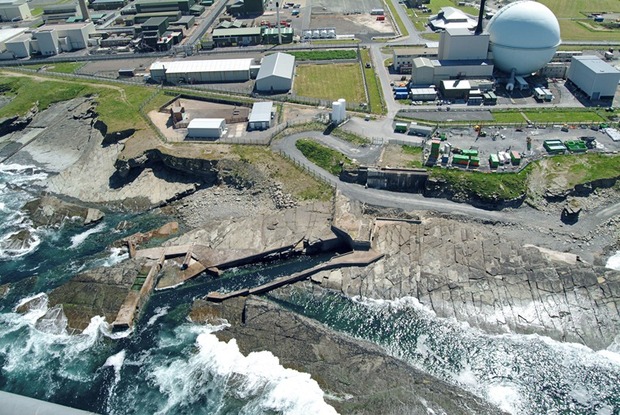Major Dounreay hazard destroyed
19 Jun 2012
One of the most dangerous legacies of Britain’s early atomic research has been destroyed
“The potential for something going wrong was very high,” said Mike Brown, decommissioning manager of reactors at Dounreay. “We had to engineer out an awful lot of hazards to make this safe”
Earlier this year, Brown’s team of 25 engineers neutralised the liquid metal coolant from the primary circuit of Dounreay’s experimental fast reactor at Caithness in Scotland.
This was the second highest hazard removal on the Nuclear Decommissioning Authority’s (NDA’s) estate- the highest being at Sellafield.
“The process itself has been used before but only on clean sodium, never on anything with this level of radioactivity,” said Brown.
The problem was with the design of the 1950s fast reactor which was the first ever to be built in the UK. Back then, engineers at Dounreay made a fatal design error by allowing the fuel elements to be vented into the primary coolant.
The process itself has never been used on anything with this level of radioactivity
Two cooling circuits connected by heat exchangers were filled with more than 161,000 litres of liquid metal. The primary circuit contained 57,000 litres of the coolant – an alloy of sodium and potassium (NaK) that flowed over the fuel pins in the reactor core.
Crucially, the open vent design of the fuel cladding allowed the liquid metal to come into direct contact with the fuel, contaminating the primary coolant with huge levels of soluble radioactive caesium.

Radioactive fragments of irradiated nuclear fuel were released into the sea from the Dounreay nuclear plant in in Caithness during the 1970s.
Work on the primary circuit- a winding labyrinth of pipes nine kilometres in length- had to stop in the early 1980s when higher levels of radioactive contamination were detected. Radiation measurements of the primary coolant showed the presence of 1000 trillion becquerels of caesium-137.
The high level of radioactive contamination added to the chemical hazard of alkali metal that reacts in contact with air or water. Up until 10 years ago, there was no way of dealing with radioactivity and the danger was constantly looming over the Dounreay site.
What changed this was the development of a specialised ion exchanger developed Finland, called CsTreat. This is one of the first commercially systems to come out of a wave of selective ion exchanger technology develop in laboratories in the 1990s.
An estimated 1000 trillion becquerels of caesium-137 was removed from the coolant which turned the 57 tonnes of liquid metal into 20,000 tonnes of salty water
“We had tonnes and tonnes of sodium, tonnes of potassium and only few grams of radioactive caesium,” said Brown. “These all have identical chemical properties. The clever thing was having a resin that could take out the caesium and not be affected by all the sodium and potassium.”
A purpose-built chemical plant processed the last of 57,000 litres of liquid metal lifted from the primary cooling circuit of the experimental fast breeder reactor. The plant was designed to lift the liquid metal in small batches, neutralise the alkalinity with acid and extract the caesium via ion exchange.
In 2007, the first of a total of 354 batches was lifted from the reactor. Each batch underwent chemical neutralisation to convert the alkali metal to water before being passed through ion exchange columns that trapped the caesium.
Initial calculations predicted that the plant would decontaminate the effluent by a factor of 1000. In fact, decontamination rates of up to 4 million were achieved during the operation, reducing levels of radioactivity in the effluent to below the limit of detection.
It’s a simple process but it takes quite a lot of skill to run it
“You can actually drink the stuff that comes out of the back end, although it’s a bit salty,” said Brown. “We really weren’t expecting these levels of decontamination. It’s a fantastic engineering achievement”.
But the process didn’t come without its challenges. The biggest problem, which caused around three months downtime, was with blockages around pipes hangers, valves and nitrogen lines where cool spots would stop the NaK flow.
“You can’t just heat it up and get rid of it, you have to cut the pipework out,” said Brown. “And you can’t just cut the pipework out in air or it will burn, so you have to build a big glove bag around it and weld your pipe work inside a nitrogen atmosphere. That’s caused us some difficulties. All of this was in a huge radiation background so it got quite complicated.”
After doing this a number of times, the team overcame placing trace heating on all the pipework. “It’s a simple process but it takes quite a lot of skill to run it,” added Brown. “The sodium and potassium tend to block the nozzles as they mix in with the caustic and you have to find ways of keep those clear. We use a steam boiler to do that.”
An estimated 1000 trillion becquerels of caesium-137 was removed from the coolant during the chemical process which turned the 57 tonnes of liquid metal into 20,000 tonnes of salty water and took four years to complete. In total, the plant cost £25m to build and £2.5m a year to run.
The resin columns used to trap the caesium will now be cemented up and managed as higher-activity waste.
“It’s been a fantastic achievement by the whole team to deliver this milestone a year ahead of schedule and to higher environmental standards than anyone thought possible at the design stage,” said Andy Swan, the engineer in charge of the reactor decommissioning.
The next step is to cleanse the residual traces from the primary circuit pipework and destroying small pockets in other vessels. When complete, a robotic arm will reach into the reactor vessel and begin removing the burst fuel pin and almost 1000 breeder elements still positioned around the core.





